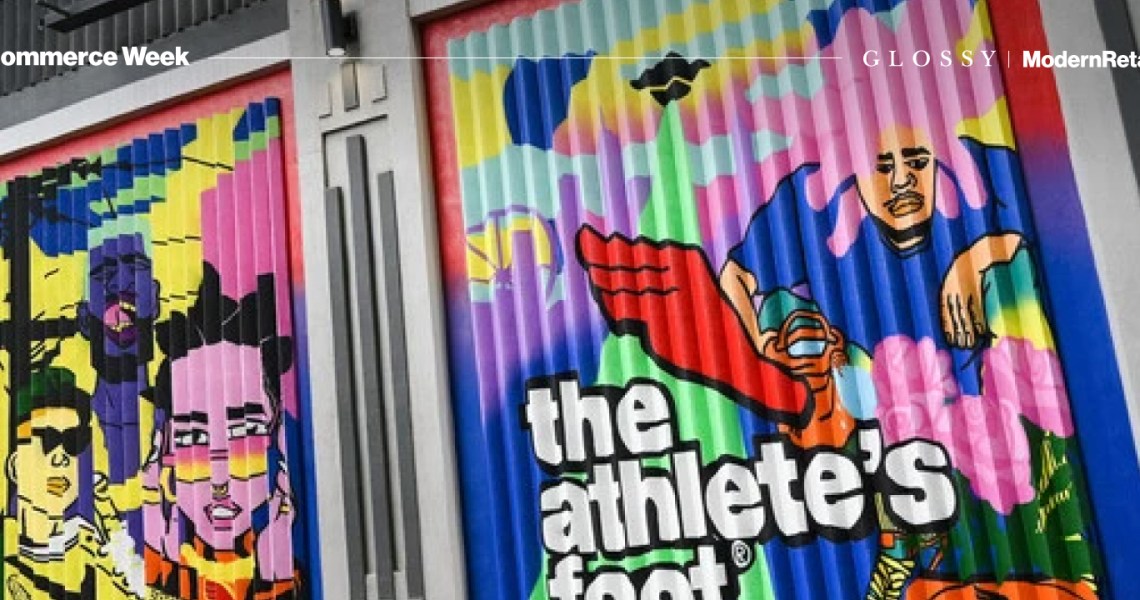This story was first reported on and published by Glossy sibling site Modern Retail.
Concept stores are becoming footwear retailers’ testing grounds for localization.
As part of its new Lace Up strategy, Foot Locker said in March that it is planning to expand its community-focused concept stores located in areas where people are drawn to sneakers. Nike, on the other hand, opened a new Nike Unite retail store concept in Harlem in late October, which is designed to reflect the local community and help people in the area connect with sports. Similarly, The Athlete’s Foot debuted a neighborhood store concept in Atlanta, Georgia, this month featuring hyper-localized product offerings and community engagement initiatives.
Footwear retailers are taking their localization strategies a step further through highly experiential store concepts. Experts said concept stores — when retailers rethink the layouts and aesthetics of new storefronts — are an effective medium to appeal to locals due to their experiential nature. Footwear retailers are introducing these community-based concept stores which have certain qualities that reflect the geographies they’re in. Ideally, these stores would allow retailers to connect with shoppers in a personalized way that can’t be achieved with a more cookie-cutter store model.
Footwear retailers’ use of concept stores to host their localization strategies is a culmination of some of the latest trends in the industry. Shoppers are craving in-store shopping and brands are increasingly pushing personalization as a strategic brand priority, said Jackie Walker, retail experience strategy lead for North America at Publicis Sapient.
“There’s this almost perfect storm for a bit of a redefinition of brick and mortar,” she said. “Community-based stores really become a natural rallying point for how to think about meeting customers where they are in this climate.” She added that a common tactic retailers use to appeal to locals is by teaming up with local artists or athletes, personalizing their assortment based on what locals want and adding local elements to the store’s design.
In-store traffic is indeed growing. Comparable sales at Foot Locker rose by 4.2% due to increased traffic and access to quality inventory in the fourth quarter. Nike’s direct sales, which encompass its website and owned-and-operated stores, climbed 17% year-over-year in the third quarter.
Ad position: web_incontent_pos1
Foot Locker’s community store located in Compton, California offers community events as well as exclusive product and custom store artwork from local artists. Meanwhile, The Athlete’s Foot stocked the Atlanta neighborhood store with merchandise from local sports teams and local designers. When the store opened, TAF hosted a live performance from rapper Baby Tate who hails from Atlanta.
For Foot Locker, localization also means tailoring the assortment and the experiences in the community store based on the neighborhood it is situated in. These stores are also larger than other store concepts, coming it at an average of 15,000 square feet. Much like Foot Locker, Rack Room Shoes also introduced a new concept store in Charleston, South Carolina where shoppers can gain access to exclusive items — such as colors and prints — available only in this location.
“These are meaningful expressions in our communities and our activations truly inspire and engage,” said Anthony Aversa, svp of store development at Foot Locker. “These community stores also offer first-time job opportunities for much of the community, which is extremely important.”
Ethan Chernofsky, svp of marketing at Placer.ai, said that the primary goal for these store concepts is to make shoppers fall in love with the brand and making people understand what the brand stands for. “It’s almost like selling product is not the primary goal,” he said. “The evolution of retailers recognizing how do we understand each location. In an ideal world, you would ask how do we make how do we maximize the potential of every single location we have.”
There can be serious consequences when the interests of local communities are ignored with some losing sales and eventually closing down, said Ross Forman, managing director at BDO. For example, when U.S. retail giants, including Target, attempted to enter the Canadian market, they made the mistake of using the same merchandising strategy in Canada that they used on their home soil.
Ad position: web_incontent_pos2
“They’re using it more as a testing [ground] to see what works, what appeals, what sticks,” Forman said. “And so, you don’t have to throw the baby out with the bathwater.”
Forman said that store concepts offer more memorable experiences in retail localization than a standard location, which could help companies stand out in the market. Through these locations, retailers are also able to highlight programs relevant to locals. For instance, Nike Unite stores are also expected to support local nonprofits and schools that give kids more chances to be active.
In order for localized store concepts to work, the brand itself has to make sure that the neighborhood they want the store to be in matches the brand itself, said Balaji Santhanam, associate partner, retail, consumer goods and logistics at Infosys Consulting. For example, Champs Sports store concept, dubbed Homefield, reflects the large athlete population in southern Florida and features a multi-sport court.
“Every brand needs to look at their customer base and pick the right reasons for trying out the concept store in terms of the target market,” said Santhanam.




